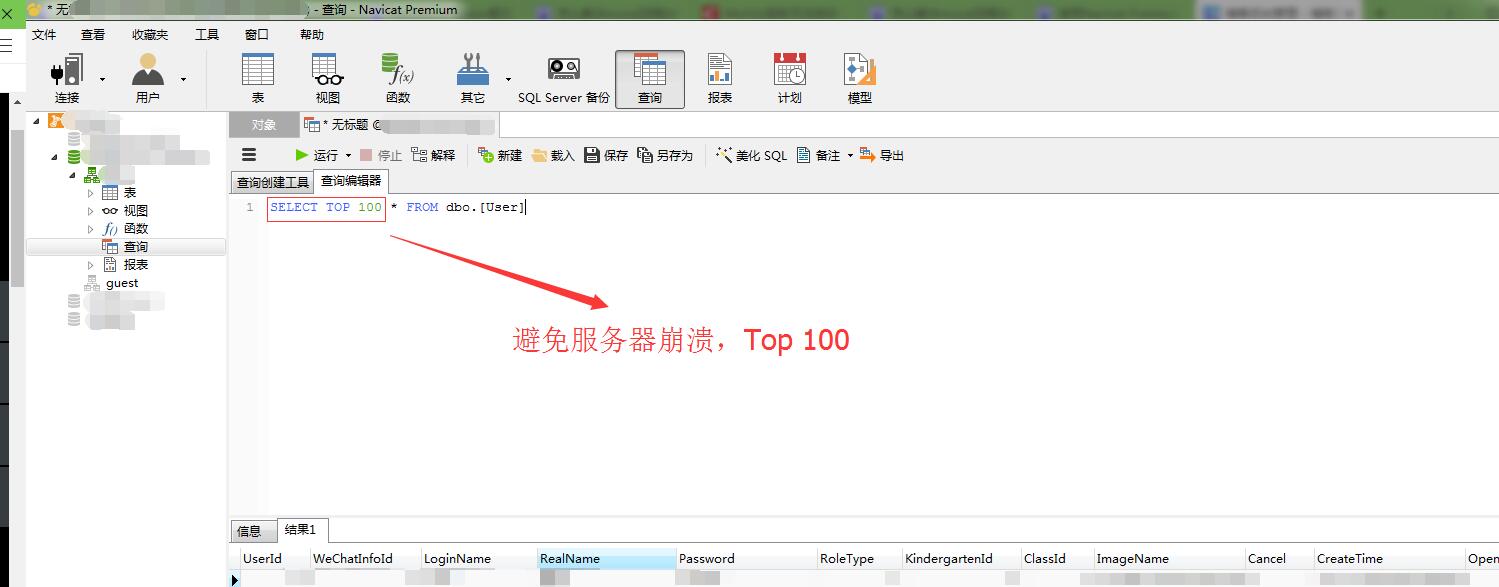作用:
- 学习笔记,整理日志,
- 发布日记,杂文,所见所想
- 撰写发布技术文稿(代码支持)
- 撰写发布学术论文(LaTeX 公式支持)

- Ctrl+R (全部运行)
- Ctrl+Shift+R(选中运行)
Sql server语句(增删改查):http://blog.csdn.net/yu_rong/article/details/49208171
增加:
删出:
改查:
/*--------------------------------------------------
--SQL Server 2012 & T-SQL Lesson 3 - BasicQueries
----------------------------------------------------*/
--Topic 1
SELECT <table fields list>
FROM <table names list>
WHERE <row constraints specification>
GROUP BY <grouping specification>
HAVING <grouping selection specification>
ORDER BY <order rules specification>
--Topic 2
use [AdventureWorks2012]
go
select Top 100 * from [Production].[Product]
SELECT *
FROM SALES.SALESORDERDETAIL
--Topic 3
select * from [Production].[Product]
select ProductID, Name, ProductNumber, Color, Size, ListPrice
from Production.Product
select ProductID, Name, ProductNumber, Color, Size, ListPrice
from Production.Product
order by listprice desc --desc=descending order ; asc=ascending order
select ProductID, Name, ProductNumber, Color, Size, ListPrice
from Production.Product
order by listprice desc,Name
select ProductID, Name, ProductNumber, Color, Size, ListPrice
from Production.Product
order by 2
--Topic 4
select ProductID, Name, ProductNumber, isnull(Color,''), isnull(Size,''), ListPrice
from Production.Product
--Topic 5
select ProductID, Name, ProductNumber,
isnull(Color,'') as Color, isnull(Size,'') as Size123, --using an alias
ListPrice
from Production.Product
select ProductID, Name as ProductName, --using an alias
'The list price for ' + ProductNumber + ' is $ ' + convert(varchar,ListPrice) +'.' ,--using the concatenation to join character end-to-end.
'The list price for ' + ProductNumber + ' is $ ' + convert(varchar,ListPrice) +'.' as [Description] --using brackets to let SQL server conside the strin as a column name
from Production.Product
--Topic 6
select BusinessEntityID,rate from [HumanResources].[EmployeePayHistory]
select BusinessEntityID
,rate*40*52 as AnnualSalary
,round(rate*40*52,1) as AnnualSalary
,round(rate*40*52,0) as AnnualSalary
from [HumanResources].[EmployeePayHistory]
select BusinessEntityID
,(rate+5)*40*52 as AnnualSalary
from [HumanResources].[EmployeePayHistory]
--Topic 7
select * from [Sales].[SalesOrderHeader]
select * from [Sales].[SalesOrderHeader]
where SalesPersonID=275
select * from [Sales].[SalesOrderHeader]
where SalesOrderNumber='so43670'
select * from [Sales].[SalesOrderHeader]
where TotalDue>5000
select SalesOrderID,OrderDate,SalesPersonID,TotalDue as TotalSales
from [Sales].[SalesOrderHeader]
where SalesPersonID=275 and TotalDue>5000 --Comparison conditions: =,>,<,>=,<=,<>
select SalesOrderID,OrderDate,SalesPersonID,TotalDue as TotalSales
from [Sales].[SalesOrderHeader]
where SalesPersonID=275 and TotalDue>5000 and Orderdate between '2005-08-01' and '1/1/2006'
select SalesOrderID,OrderDate,SalesPersonID,TotalDue as TotalSales
from [Sales].[SalesOrderHeader]
where SalesPersonID=275 and TotalDue>5000 and Orderdate >= '2005-08-01' and Orderdate < '1/1/2006'
select * from [Production].[Product]
where name ='Mountain-100 Silver, 38'
--Topic 8
select * from [Production].[Product]
where name like'Mountain'
select * from [Production].[Product]
where name like'%Mountain%' --Wildcard % matches any zero or more characters
select * from [Production].[Product]
where name like'mountain%' -- "_" matches any single character
select * from [Production].[Product]
where name like'_ountain%'
--Topic 9
select * from [Production].[Product]
where color in ('red','white','black')
select * from [Production].[Product]
where size in ('60','61','62')
select * from [Production].[Product]
where class not in ('H') -- same as using: <> 'H'
--Topic 10
select * from [Production].[Product]
where size is null
select * from [Production].[Product]
where size is not null
--Topic 11
select * from [Production].[Product]
where color ='white'or color ='black'
select * from [Production].[Product]
where color ='white'and color ='black'
select SalesOrderID,OrderDate,SalesPersonID,TotalDue as TotalSales
from [Sales].[SalesOrderHeader]
where (SalesPersonID=275 or SalesPersonID=278) and TotalDue>5000
--Topic 12
select count(SalesPersonID)
from [Sales].[SalesOrderHeader]
where SalesPersonID is not null
select distinct(SalesPersonID)
from [Sales].[SalesOrderHeader]
where SalesPersonID is not null
select count(distinct(SalesPersonID))
from [Sales].[SalesOrderHeader]
where SalesPersonID is not null
--Topic 13
select
Avg(TotalDue) as AverageTotalSales --aggregate functions
from [Sales].[SalesOrderHeader]
select
Avg(TotalDue) as AverageTotalSales
,Min(TotalDue) as MinimumTotalSales
,Max(TotalDue) as MaximumTotalSales
,Sum(TotalDue) as SummaryTotalSales
from [Sales].[SalesOrderHeader]
select SalesPersonID,Max(TotalDue) as MaximumTotalSales
from [Sales].[SalesOrderHeader]
--Error Message: Column 'Sales.SalesOrderHeader.SalesPersonID' is invalid in the select list
--because it is not contained in either an aggregate function or the GROUP BY clause.
select SalesPersonID,Max(TotalDue) as MaximumTotalSales
from [Sales].[SalesOrderHeader]
where SalesPersonID is not null
group by SalesPersonID
order by SalesPersonID
select SalesPersonID,OrderDate,Max(TotalDue) as MaximumTotalSales
from [Sales].[SalesOrderHeader]
where SalesPersonID is not null
group by SalesPersonID,OrderDate --Remember to put all un-aggregated columns after "group by"!!!
order by SalesPersonID
select SalesPersonID,OrderDate,Max(TotalDue) as MaximumTotalSales
from [Sales].[SalesOrderHeader]
where SalesPersonID is not null
group by SalesPersonID,OrderDate
having Max(TotalDue)>150000
order by SalesPersonID
----The classical T-SQL query!!!
select SalesPersonID,OrderDate,Max(TotalDue) as MaximumTotalSales
from [Sales].[SalesOrderHeader]
where SalesPersonID is not null and OrderDate >='2007/1/1'
group by SalesPersonID,OrderDate
having Max(TotalDue)>150000
order by OrderDate desc
导入:
导出:
http://blog.sina.com.cn/s/blog_4eca88390102vc9g.html
http://www.cnblogs.com/leskang/p/5922349.html
https://www.exehack.net/1096.html
http://blog.csdn.net/znyyjk/article/details/52717336
http://www.cnblogs.com/acpe/p/4970765.html
http://blog.csdn.net/u011863767/article/details/52764948
http://blog.csdn.net/nanyanglu/article/details/53187796
http://blog.sina.com.cn/s/blog_8439a4e50101mlc3.html
纯属个人观点,仅供参考!